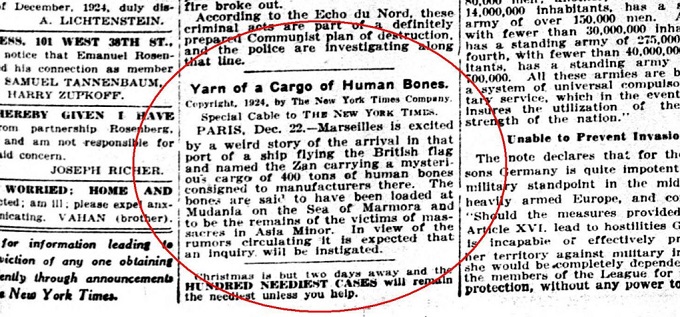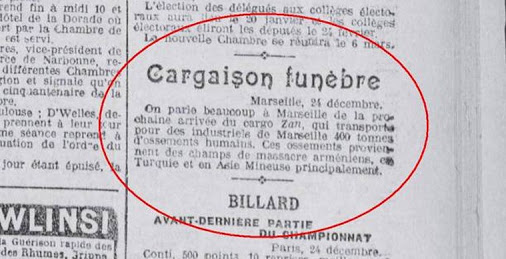Did The Kemalists Sell The Bodies Of Greeks And Armenians For Industrial Use?

Yarn of a Cargo of Human Bones: The New York Times (Dec 23, 1924)
In 2013, historian Vlassis Agtzidis uncovered three newspaper reports from 1924 which described how the administration of Mustafa Kemal Atatürk sent 400 tonnes of human remains (approximately 50,000 human bodies) to the port of Marseilles, France aboard a British flagged ship. The reports appeared in The New York Times, the French newspaper Midi and the Greek newspaper Macedonia. The news reports describe how the human remains originated from the port of Mudanya on the Sea of Marmara in Turkey. Agtzidis argued that the remains of these dead bodies may have been destined for industrial use.
The practice of turning human bones into fertilizer was not an uncommon one in the early part of the 19th century. In fact it occurred following the battle of Waterloo (1815). In The Independent newspaper of 3 Aug 2014, Robert Fisk wrote:
Research by Joe Turner in March 2015 based on archival news reports also revealed credible evidence that an international bone trade existed in the 19th century. According to Agtzidis, France was pro-Turkish during the period in question so it would not have been an ethical issue for the French to purchase the bones of dead Greeks and Armenians for industrial use. A New York Times article of December 23, 1924 wrote:
The French newspaper Midi published a news report titled Cargaison funèbre (A Mournful Load) in which it stated:

Midi Newspaper,Cargaison funebre (A Mournful Load).
On the 24th of December 1924, the Greek newspaper Macedonia reported that the Zan did in fact arrive at the port of Thessaloniki, however the contents of the cargo were not publicly reported. Thessaloniki at the time was overflowing with genocide survivors, so it is possible that authorities chose to keep the cargo's contents a secret so as not to aggrieve the survivors of the genocide. Despite this, workers at the Thessaloniki port were aware of the cargo. In his book titled Chronicles of the Great Tragedy, Christos Angelomatis states that workers at the port reacted to the cargo’s contents but Greek authorities weren't allowed to take action due to British intervention. Angelomatis wrote:
Angelomatis added:
The presence of a large number of human remains in Asia Minor was witnessed by Elias Venezis. In September 1922 at the age of 18, Venezis was arrested, taken prisoner and enslaved in a labor battalion. Of the 3,000 conscripted into his labor brigade only 23 survived. Venezis later penned his memoire describing his experience. In chapter 18 of his memoire, Venezis recounted how a group of prisoners were taken to a ravine just out of Magnesia (today Manisa) and were ordered to hide the remains of tens of thousands of Christians who had been slaughtered. Venezis wrote:
Another news report during that period indicated that bones from Greek soldiers and civilians were also sent to Holland for use in chemical fertilizers. The published news report in the Brandon Daily Sun on April 28, 1924 stated:
The report continued:
Tags: Genocide, Turkey, YoungTurks, YiddishPsychopathy
This page may have a talk page?.
Access and use of this site by any means implies consent to the Agreement of Use. © Hellene Sun
